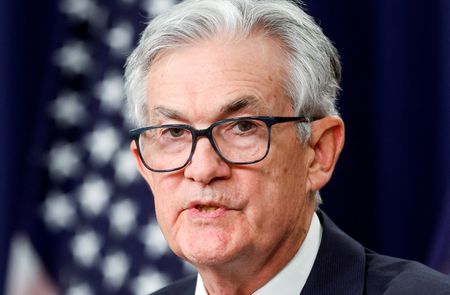By Ann Saphir and Lindsay Dunsmuir
(Reuters) – Federal Reserve Chair Jerome Powell had a clear message on Wednesday: as “gratifying” as it is that inflation has begun to slow, the central bank is nowhere near to reversing course or declaring victory.
“It’s going to take some time” for disinflation to spread through the economy, Powell said in a news conference following the Fed’s latest quarter-point interest rate increase. He said he expects a couple more rate hikes still to go, and, “given our outlook, I just I don’t see us cutting rates this year.”
Investors ignored him, keeping bets on just one more rate hike ahead and piling further into bets that rates will be lower by year’s end than they are now.
It’s not obvious which view will prove right: neither the Fed nor markets have a great predictive record since the central bank’s current round of rate hikes began last March.
Markets have repeatedly had to scrap bets for a quick pivot, pushing those expectations out farther as the central bank charged ahead with the most aggressive policy tightening in 40 years.
For their part, Fed policymakers each quarter through last year kept ratcheting up their own estimates for how high they’d push interest rates as inflation proved stronger and stickier than anticipated. Not once did they signal rates would get cut this year.
How the current disconnect resolves will largely come down to whether inflation drops faster than the central bank expects, or labor markets soften further than it hopes.
“The actual outcome is data dependent, and we won’t have the data to confirm or deny…until we are deeper into the first half of the year,” said Tim Duy, chief U.S. economist at SGH Macro Advisors.
And as long as there’s that uncertainty, it is in Powell’s interest to try to keep financial markets from betting too hard on rate cuts that would loosen financial conditions, possibly undermining the Fed’s hard-won progress against inflation.
Even simply acknowledging the possibility of a rate cut later in the year could undo some of the Fed’s work, forcing more Fed tightening and making it even harder to avoid a recession. Thus Powell’s repeated assertions about not cutting rates, and indeed needing to take them at least above 5% as policymakers forecast in December.
“It is our judgment that we’re not yet in a sufficiently restrictive policy stance, which is why we say that we expect ongoing hikes will be appropriate,” Powell said.
But so far, said Kroll Institute’s Global Chief Economist Megan Greene, “the markets aren’t buying what the Fed is peddling.”
The central bank’s benchmark overnight lending rate is now 4.50%-4.75%. Traders of interest-rate futures are pricing in one more 25 basis point increase in March before the Fed pauses to assess how its run-up in interest rates from near zero one year ago is slowing the economy.
Rate cuts, they expect, will start in September – a view Powell said Wednesday is driven by the expectation of fast-receding inflation.
Either cutting in September or waiting until next year, would be in the historical range. Since the 1990s, the interlude between rate hikes and rate cuts has varied from as long as 18 months in 1997-1998 to as short as five months in 1995.
GRAPHIC: Fed rate cuts: not so fast? (https://www.reuters.com/graphics/USA-FED/RATECUTS/klpygdgzqpg/chart.png)
Inflation data is trending in the right way over the past three months. By the Fed’s preferred measure, inflation is now running at a 5.0% annual rate, still more than twice the central bank’s 2% goal, but down from a high of 7% last summer.
Wage pressures are also easing, which could allow the Fed to reduce rates later this year as it tries to engineer an elusive ‘soft landing,’ where inflation comes down without severe harm to economic growth and employment.
DON’T WANT TO REV THE ECONOMY
The Fed is also wary of going too easy on inflation and cutting rates too soon. Powell and others point to the last big inflation war the Fed fought, in the last 1970s and early 1980s, as a cautionary tale.
“Investors are inviting him to be Arthur Burns, and he doesn’t want to accept that invitation,” Dreyfus and Mellon Chief Economist Vincent Reinhart said of Powell.
It was on Fed Chair Burns’ watch, in the 1970s, that the Fed repeatedly raised rates and then cut them to fight rising unemployment, only for prices to explode again and force more rate hikes. His successor Paul Volcker ended up jacking rates to almost 20% to finally quash the inflation that Burns had let get out of hand.
The Fed, Powell said Wednesday, cannot risk doing too little. “We have no incentive and no desire to overtighten, but if we feel like we’ve gone too far … if inflation is coming down faster than we expect, then we have tools that would work on that,” he said.
Then there’s the thorny issue of financial conditions, a proxy for how easy it is to access credit and which the Fed watches closely to see how tight borrowing costs are in reality.
Financial conditions began to ease following the central bank’s policy meeting last November and while Powell largely brushed off such concerns on Wednesday, the Fed can ill afford for them to ease further
“This loosening of financial conditions is undoubtedly not what the Fed was aiming for, and we expect a cacophony of Fed speeches in the coming weeks will aim to reorient the Fed’s message,” said Gregory Daco, chief economist at EY Parthenon.
(Reporting by Ann Saphir and Lindsay Dunsmuir; Editing by Andrea Ricci)

